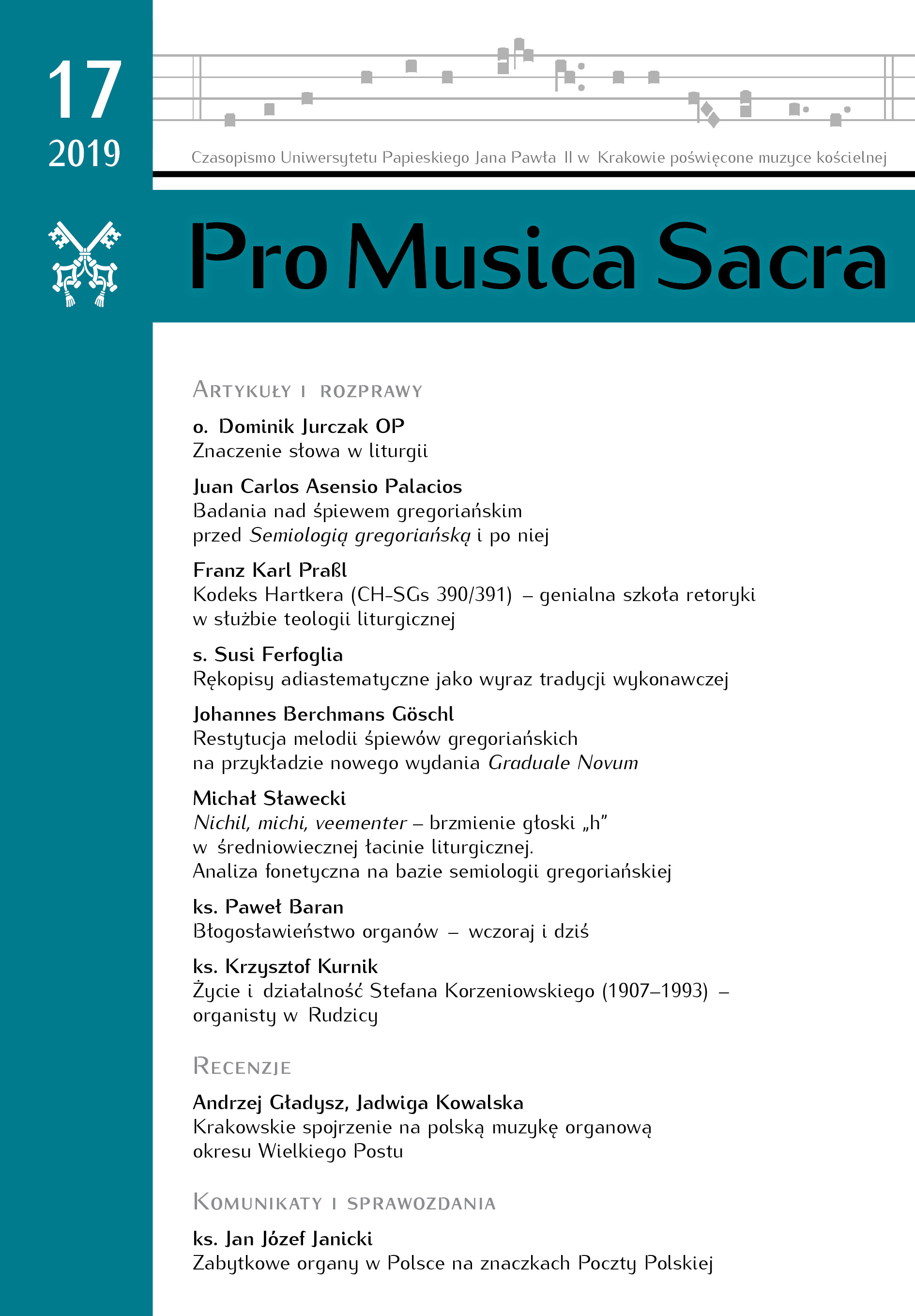Rękopisy adiastematyczne jako wyraz tradycji wykonawczej
DOI:
https://doi.org/10.15633/pms.3492Słowa kluczowe:
rękopisy adiastematyczne i diastematyczne, semiologia gregoriańska, egzegeza brzmieniowa, neuma, liturgia, notacja sanktgalleńska i notacja laońska czy metzeńska, Einsiedeln 121, Laon 239, praktyka wykonawczaAbstrakt
Artykuł ma na celu ukazanie, w jaki sposób studiowanie rękopisów adiastematycznych może nas doprowadzić nie tylko do najwierniejszej interpretacji utworów gregoriańskich, ale do tego, co najważniejsze – do rozumienia treści duchowo-teologicznej tych śpiewów. Śpiew gregoriański jest prawdziwą egzegezą brzmieniową, a semiologia jest tą nauką, która – poprzez pytanie, dlaczego został wykorzystany taki, a nie inny znak nad określoną neumą – otwiera drogę do odzyskania pewnej praktyki wykonawczej, która nie jest kopią przeszłości, ale staje się rzeczywistością liturgiczną dzisiaj. W tym celu zostały poddane analizie porównawczej dwa śpiewy z formularza mszy o północy na Boże Narodzenie: Introitus: Dominus dixit oraz Communio: In splendoribus sanctorum. Analiza opiera się na dwóch źródłach, powszechnie przyjętych w badaniach semiologicznych, a mianowicie na rękopisie Einsiedeln 121 zawierającym notację sanktgalleńską oraz na rękopisie Laon 239 przekazującym nam notację laońską albo metzeńską. Na tej podstawie został przedstawiony zamysł postępowania kompozytora gregoriańskiego oraz sposób, w jaki rzutuje on na praktykę wykonawczą.Bibliografia
Agustoni L., Göschl J. B., Introduzione all’interpretazione del canto gregoriano, Roma
Benedykt XVI, Katecheza podczas audiencji ogólnej w Watykanie, 16 listopada 2011,
www.ekai.pl/dokumenty/katecheza-benedykta-xvi-podczas-audiencji-ogolnej-wwatykanie-
-listopada-2011-r/ (20.10.2018).
Cardine E., Granice semiologii w śpiewie gregoriańskim, „Studia Gregoriańskie” 6 (2013),
s. 9–23.
Cardine E., Primo anno di canto gregoriano, Solesmes 2015.
Gajard J., Le plus belles mélodies grégoriennes, Solesmes 1985.
Göschl J. B., Jedność w wielości: podstawy interpretacji śpiewu gregoriańskiego, tłum.
M. Białkowski, „Studia Gregoriańskie” 6 (2011), s. 73–99.
Joppich G., Die rhetorische Komponente in der Notation des Codex 121 von Einsiedeln,
w: Codex 121 Einsiedeln. Kommentar zum Faksimile, Weinheim 1991, s. 119–188
(Acta Humaniora).
Hucbald z Saint-Amand, De harmonica, ed. A. Traub, „Beiträge zur Gregorianik” 7 (1989), s. 3–99.
Nadolski B., Liturgika, t. 2. Liturgia i czas, Poznań 2013.
Praßl F. K., Scriptor interpres. Sui notatori e la loro individualità, „Studi Gregoriani” 22 (2006), s. 41–64.
Rękopis Einsiedeln 121, www.ecodices.unifr.ch/en/list/one/sbe/012 (6.12.2018).
Rękopis Laon 239: www.manuscrit.ville-laon.fr/_app/ms/OEB/Ms239/index.html (6.12.2018).
Świerzawski W., Liturgia uobecnia i odsłania misterium Chrystusa i Kościoła, w: Mysterium Christi 1. Fundamentalne rzeczywistości Liturgii, Zawichost–Kraków–Sandomierz 2012.
Turco A., Il neuma e il modo. Le incidenze verbo-modali sulla notazione neumatica, Città del Vaticano 2018.
Pobrania
Opublikowane
Numer
Dział
Licencja
Autorzy publikujący w czasopiśmie udzielają jego wydawcy zgody o następującej treści:
- Autor zachowuje autorskie prawa majątkowe do utworu, a jednocześnie udziela wydawcy czasopisma zgody na jego pierwszą publikację w wersji drukowanej i wersji online na licencji Creative Commons Uznanie autorstwa 4.0 Międzynarodowe oraz zgody na wykonywanie opracowań, w tym przekładów.
- Autor ma możliwość udzielania zgody niewyłącznej na opublikowanie utworu w wersji, która ukazała się w czasopiśmie (np. zamieszczenia go w repozytorium instytucjonalnym lub opublikowania w książce), wraz z informacją o jego pierwszej publikacji w czasopiśmie.
- Autor może umieścić swój utwór online (np. w repozytorium instytucjonalnym lub na swojej stronie internetowej) jeszcze przed zgłoszeniem utworu do czasopisma.

